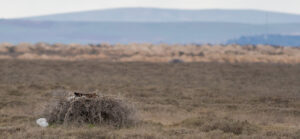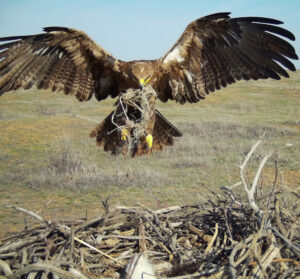Third International Scientific and Practical Conference “Eagles of the Palearctic: Study and Conservation”
Raptors Conservation. Suppl. 2. Proceedings of Conferences
Species action plan for conservation of an isolated Steppe Eagle population in Turkey
Özbahar İ., Özkoç Ö.Ü. (Turkish Nature Research Society, Ankara, Turkey)
Horvath M. (MME BirdLife Hungary, Budapest, Hungary)
Isfendiyaroğlu S.C. (İstanbul Bird Observatory, İstanbul, Turkey)
Tatar B. (Turkish Ministry of Forestry and Agriculture, Ankara, Turkey)
Rubinić B. (AGRECO GEIE, Brussels, Belgium)
Contact:
Ilker Özbahar ilker.ozbahar@dogaarastirmalari.org.tr
Ömral Ünsal Özkoç ozkoc@dogaarastirmalari.org.tr
Márton Horváth horvath.marton@mme.hu
Süreyya C. İsfendiyaroğlu Sureyyaisfen@gmail.com
Burak Tatar burbody@gmail.com
Borut Rubinić borut.rubinic@agreco.be
Recommended citation: Özbahar İ., Özkoç Ö.Ü., Horvath M., İsfendiyaroğlu S.C., Tatar B., Rubinić B. Species Action Plan for Conservation of an Isolated Steppe Eagle Population in Turkey. – Raptors Conservation. 2023. S2: 220–223. DOI: 10.19074/1814-8654-2023-2-220-223 URL: http://rrrcn.ru/en/archives/35035
Steppe Eagle (Aquila nipalensis) is a globally Endangered (EN) species according to IUCN Red List, with a breeding range extending through the arid zones of southern Russia and Kazakhstan from Kalmykia in the west to Dauria in the east. There is a small, isolated breeding population in Turkey, discovered in 2003, which lost contact with the main breeding range. Although there are studies carried out between 2015 and 2021, the size of the isolated population is not exactly known.
To protect this small population on the brink of extinction, the General Directorate of Nature Conservation and National Parks (GDNCNP), which is officially responsible for wildlife conservation, programmed to prepare a species action plan in 2021. As part of the “Preparation, Implementation and Monitoring of Species Action Plans for Endangered Species in Turkey within the Concept of a New Methodology”, shortly “Endangered Species” project, Steppe Eagle was selected, based on a prioritization study, to be one of the pilot species for which species actions to be prepared. Field studies were conducted in the 2022 breeding season to identify threats causing stress to the Steppe Eagle. During the breeding studies in 2022, it was determined that 4 pairs of Steppe Eagles were confirmed to be breeding in Central Anatolia, and 4 pairs attempted to breed.
During the field studies, threat factors were listed based on direct observations, indirect observations (nest records, mortality records, etc.), and bilateral discussions with local communities. Using the threat analysis adopted by IUCN and adapted to Turkey within the framework of the same project, a national-level threat analysis was conducted. Direct threat factors causing stress to the species were listed as conversion of grasslands into agricultural areas, excessive use of groundwater and surface water leading to the drying of wetlands, power transmission lines, human activities and grazing pressure on breeding islands in wetlands, illegal hunting, predation, researcher pressure, hybridization with Eastern Imperial Eagles (Aquila heliaca), and artificial materials in nests. Additionally, the use of rodent poisons was also identified as a potential threat.
As a result of the threat analysis, the threats with the highest level of impact on the species were identified as the conversion of grasslands into agricultural areas and excessive water usage. These threats result in the transformation of steppe habitat and decrease in the species' food sources. Another high-level threat is illegal hunting.
The identified threats were transferred to a problem tree and, following the method generated in the “Endangered Species” project, problem tree was transformed to a result chain. In the result chain, the selected results for eliminating/reducing threats were defined by identifying intervention points and transforming them into objectives. Activities were defined to achieve the identified objectives.
Within the scope of the 10-year action plan a total of 34 activities were designed under 9 objectives to be achieved. Eight out of the 9 objectives involve conservation, and one involves research-related activities. The aim of the 10-year plan is to conserve and support the breeding population of the species in Turkey.

Steppe Eagle (Aquila nipalensis) incubating on a bush nest, Kırşehir province, Turkey, 22 April 2015. Photo by M. Horváth.

